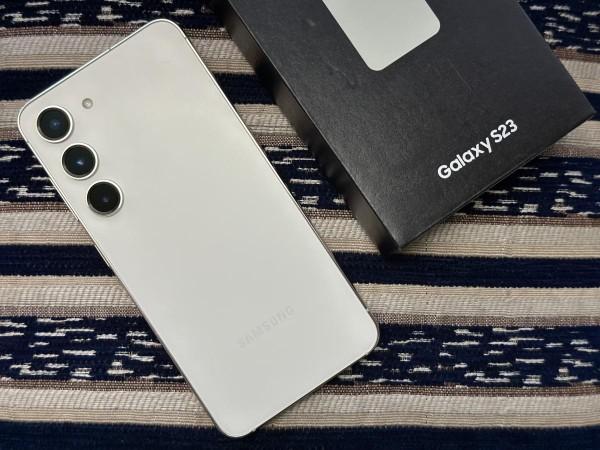Samsung Galaxy S23 was one of the three flagship launches from Samsung this year and the demo zones at the Opera House showcasing the Galaxy S23 were quite packed, grabbing a lot of eyeballs. After having used the phone for the last couple of days, we now see what the underreported hype was all about.
Samsung Galaxy S23's price tag is light on eyes; doesn't raise those brows. It comes in 128GB and 256GB storage configurations, priced at Rs 74,999 and Rs 79,999, respectively. Doubling the storage for that Rs 6,000 extra makes more sense. Unlike the limited storage options, there's more to choose from in terms of colours: Phantom Black, Cream, Green and Lavender. Samsung sent us the Cream shade for review, which is a matte white hue.

Before we dive into the review, take a quick glance at the key features the phone offers. Clearly, the Galaxy S23 is every bit flagship on paper.
Samsung Galaxy S23: Features to know
Display: 6.1-inch Dynamic AMOLED 2X, 120Hz, 1080x2340 resolution, Victus 2
CPU: Snapdragon 8 Gen 2 for Galaxy
Storage: 128GB/256GB
RAM: 8GB
Main camera: 50MP f/1.8, Dual Pixel PDAF, OIS + 10 MP, f/2.4, PDAF, OIS, 3x optical zoom + 12MP ultra-widef/2.2, 13mm
Front camera: 12 MP, f/2.2, Dual Pixel PDAF
Battery: 3,900mAh with 25W fast charging
OS: Android 13 based OneUI 5.1
Add-ons: UD ultrasonic fingerprint scanner, stereo speakers, IP68
Design and display
Samsung Galaxy S23, unlike the S23 Ultra, has some visual characteristics to set it apart from last year's S22. The camera module shifts from the Contour Cut to floating lenses as seen in the Ultra model. This is a welcome change as it adds continuity to the entire flagship series. The three protruding cameras with protective rings on the matte finish Gorilla Glass Victus 2 look elegant and the frame, in case of white, compliments the overall look with its matte golden hue.

But what's truly working for the S23 is the compact form factor. The S23 is the same size as the iPhone 14 Pro but feels more compact when held in hand. Single-hand usability in the S23 is the best out there. The button placements and the ports haven't changed, and they remain super accessible.

One thing that would have been nice and kind of refreshing to see in the S23 is if Samsung had introduced some bright and peppy colours.
As for the display, it's a 6.1-inch tall beauty with 1080x2340 pixels. The display resolution is default and there's no option to change the resolution, which is expected. But you can choose the refresh rate, Adaptive or Standard, but we recommend using the former. The icing on the cake is that the display is flat, which dismisses any chances of unintended touch. The display itself is sharp, vibrant and brighter. The camera cutout at the centre is barely visible. Under harsh light, however, the display struggles. But in most lighting situations, it worked just fine with max brightness.

The display also houses the fingerprint scanner under it. The ultrasonic scanner works efficiently. It didn't register any errors and quickly unlocked the phone, just as we expected. The overall display feedback is excellent, courtesy of those soft complementing haptics.

Overall, the S23 is the best compact flagship out there, which has a display to support it well.
Camera
Samsung Galaxy S23 houses a triple camera setup on the back and an upgraded 12MP 25mm f/2.2 selfie snapper with dual-pixel PDAF. The rear setup is made up of a 50MP primary sensor paired with 10MP telephoto and 12MP ultra-wide sensors, which is the same as last year's S22. If you're wondering what's the change, it's got to do with the post-processing enabled by the Snapdragon 8 Gen 2 for Galaxy processor.
Shooting with the Galaxy S23 in daylight will yield the best results, complete with sharp details, vibrant colours and a bit warmer shade. The contrast is maintained at a high note, and the dynamic range is excellent. The main camera should be your go-to choice for all things daylight.

With one tap, you can switch between ultra-wide and 3x zoom. The optical zoom works as expected, retains maximum details and vibrant colours. There's some noise, but it's thankfully not visible unless you go looking for it in the finer details. The 3x zoom delivers as promised and works effectively in quick capture of distant subjects. There's up to 30x digital zoom, which is unusable.
The ultra-wide mode is a winner. Besides dramatic effect, the S23's ultra-wide manages well-detailed, rich-coloured photos. The results capture a satisfying amount of dynamic range and contrast. Overall, the ultra-wide shots on S23 evenly spread out quality end to end.
Then there's the portrait mode, which shoots in 1x or 3x. Both work great. The subject outlining is perfect, and manages to capture hair strands quite well. The bokeh effect is natural and soft, with options to change the background to various filters - none of which seemed good enough except for some good-old ones like zoom, spin, and colour point.

Turn to selfies, Samsung Galaxy S23 has a reputation for clicking Instagrammable pics. The S23 doesn't lose that touch, in fact, it ever-so-mildly improves it with its detailing and sharpness. Shooting against harsh lights is a breeze and portrait mode on the front camera works just as great.
In low light, you can shoot in Night mode or just Auto mode. What really matters is, the results are great in low light using the primary 50MP sensor. The phone manages good details, and colours have a truer tone, but there's some visible noise only in case of really dark settings. Using the night mode added a bit of punch to the photos, taking the result away from its natural course. We preferred shooting without Night mode for better-quality photos.
Using other modes like ultra-wide and zoom is not as great as the main photo mode. Both modes tend to pick up noise, but still, manage to maintain decent colours and dynamic range.
Shot on Samsung Galaxy S23:
Performance
Samsung Galaxy S23 is powered by the same chipset that powers the S23 Ultra. Isn't that hint enough to tell you there's no compromise on the performance? There's less confusion this year as Samsung gives its Exynos chip a pass. The overclocked chipset in the S23 seems powerful and that compact body makes for a perfect flagship. The cooling system is not as efficient as in the S23 Ultra, which we kind of expected given the compact size of the phone.

The S23 is very stable and keeps it calm no matter what you throw at it. We ran the same games and apps as we transferred over from S23 Ultra and we didn't notice any lags or stutter. In fact, the app load time is faster, and using the phone is graphically smooth. We were running 3-4 apps simultaneously and had no issues. Playing Free Fire Max was seamless, but we missed the larger screen real estate, which is why there's S23 Plus in the offering. But we thoroughly enjoyed watching our TV series on the S23, just for the pleasure of holding such a compact phone for hours together. The incredible stereos added to the experience with its thumping sound.

The S23 runs OneUI 5.1 out of the box, a familiar interface we've grown to admire over the years. The software is snappy and easy to navigate. There's no shortage of pre-loaded apps from Samsung and Microsoft, all of them tucked away from sight in dedicated folders. The best part is the software support this phone gets, like every other flagship Samsung phone, which is four major Android updates and 5 years of security updates. This means you'll get solid software support till 2026.

Battery
Samsung Galaxy S23 has a slightly bigger battery, by 200mAh to be precise. We don't see any changes in the specs that would drain the S23's battery faster than S22, except for the Snapdragon 8 Gen 2 processor, but it could go the other way as it is big on efficiency as well. In our consistent tests, the results appear to favour the latter as the S23 is better in terms of battery and if you go by the size of this smartphone and the battery it packs, the S23 can outlast its competitors.
The S23 lasted a whole day without any issues, with a 120Hz refresh rate. Putting the phone through some endurance tests drained the battery sooner, but the daily average user will find the phone to last a whole day. You can be streaming the internet, social media, making your regular calls, chatting on IMs, and throwing in some music during your commute to get through the whole day before you plug the phone to charge as you wind down in the night. The results may vary if you're on 5G, and expect extended use if you're on Wi-Fi all the time and working from home or the office.

The S23 is supported by 25W fast charging, which is an instant disappointment. No, you don't get the adaptor in the box. And with a 25W charger, you can put the phone down for an hour and get up to 85 percent. The phone fully charges in 80 minutes. On the bright side, there's no overheating. But if you have a lower-wattage adapter, it'll naturally take longer to charge. This, especially coming from a flagship when there are competitors offering blazing-fast charging, is a bummer.
Verdict
Samsung Galaxy S23 has its own fan base. The compact form factor is a winning element for us. But there's so much more in the S23 to love. The design is more refined now, the performance is top-notch, the cameras are great and there's a reliable battery despite the small size of the phone. It's not perfect though. The charging speed could have been standard for the S23 at 45W, which would've made this phone incredible. The other concern is the limited storage option, which maxes out at 256GB. At least 512GB would have been nice for serious high-end users who want the comfort of a compact phone with flagship performance.
Though we don't see S22 users upgrading to the S23, there's a lot on the table for S21 users except for the battery bit. But the competition is quite stiff in this price segment, so it still largely caters to Samsung loyalists or someone who really needs an upgrade to an ecosystem of something bigger and needs a reasonable entry ticket. Samsung Galaxy S23 does that at Rs 75K.







































